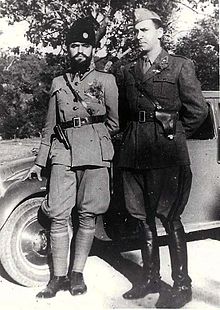Dinaric Chetnik Division

Dinaric Chetnik Division ( Serbian Динарска четничка дивизија Dinarska četnička divizija , DČD) was the self-designation of a Serbian Chetnik association under the command of the Serbian Orthodox priest Momčilo during World War II– 1999 (1907–1999) . The Chetnik Association was the main ally of the Italian fascist occupying power in the Dalmatian hinterland . The DTD is held responsible for war crimes against the Croatian civilian population. For example, for the Gata massacre in which on October 1, 1942, 96 civilians between the ages of nine months and 87 years were murdered in the Dalmatian village of Gata near Omiš .
history

After the Balkan campaign (1941) of the German Wehrmacht and the occupation of Yugoslavia by German and Italian troops, the DTD was set up in March 1942 to bring together anti-communist Chetnik groups from northern Dalmatia , the Lika and parts of western Bosnia . In June 1942 it consisted of around 3,400 Chetniks. The target strength at this time should be 4,400 men in five regiments and two departments . The regiments (each with two battalions ) were " Petar Mrkonjić " (Commander Đujić) with 700 men, " Gavrilo Princip " (Branko Bogunović) with 800 men, " Kralj Aleksandar " ( Mane Rokvić ) with 600 men, " Kralj Petar II " (Marić) with 500 men and " Onisim Popović " (Popović, later Novaković) with 600 men. The military chetnik department (with two battalions) under the command of Uroš Drenović in the Bosnian Krajina should have around 1000 Chetniks, the Bukovi Chetnik department (with one battalion) under Vlado Novaković , later Marko Crljenica , should have 200 Chetniks.
The DTD, nominally subordinated to Draža Mihailović by Đujić , had been set up with Italian help and the "legalized Chetniks" were part of the Italian Anti-Communist Volunteer Militia (MVAC) under the command of the 12th Sassari Infantry Division stationed near Knin . In joint military operations with the occupying powers, the DTD fought the Communist Tito partisans . After the capitulation of Italy in September 1943 and the entry of the German armed forces into the former Italian occupation zone of Yugoslavia, Đujić and his DTD made themselves indispensable by protecting the traffic routes (especially the railway connection Knin – Drniš ). An already ordered arrest of Đujić and the disarming of his troops by the German 114th Jäger Division was therefore not carried out.
At the end of the war, the DTD withdrew from Dalmatia to Istria with the help of the German occupation forces and in December 1944 murdered 32 Croatians in Bribir , Grižane and Tribalj and burned 70 houses and the church of Bribir.
After the war, many Chetniks escaped from the DTD with their commander to the United States and Canada , where Đujić founded the nationalist organization of the Serb Chetniks Ravna Gora in exile .
literature
- Fikreta Jelić-Butić: Četnici u Hrvatskoj: 1941–1945 (= Plava biblioteka ). Globe, 1986.
Individual evidence
- ↑ Karlo Ruzicic-Kessler: Italians in the Balkans: Occupation Policy in Yugoslavia 1941–1943 . Walter de Gruyter GmbH & Co KG, 2017, ISBN 978-3-11-054434-3 , p. 130 .
- ↑ Mihael Sobolevski: Pljačka i teror Dinarske četničke divizije na području općine Krivi put 28. i 29. prosinca 1944 [Looting and terror of the Dinaric Chetnik division in the area of Krivi Put on November 28 and 29, 1944] . In: Senjski zbornik: prilosi za geografiju, etnologiju, gospodarstvo, povijest i culture . tape 31 , no. 1 , December 2004, p. 95-113 ( srce.hr ).
- ↑ 73. obljetnica pokolja u Gatima. HRT Hrvatski radio, September 28, 2015, accessed on November 17, 2018 .
- ↑ Mehmedalija Bojić, Fabijan Trgo: The National liberation war and revolution in Yugoslavia (1941-1945): selected documents . Ed .: Vojnoistorijski institut. Belgrade 1982, p. 292 .
- ↑ Institut za historiju radničkog pokreta Dalmacije (ed.): Narodnooslobodilačka borba u Dalmaciji 1941-1945 . 2. Zbornik dokumenata. Split 1986, Izvještaj komandanta zapadnosbosanskih ličko-dalmatinskih i hercegovačkih vojnočetničkih odreda od June 16, 1942. Draži Mihailoviću o četničkim jedinicama u Hercegovini, Dalmaciji, S. Bosni zapini 1154-1155 .
- ↑ Fikreta Jelić-Butić, p. 94 f (see literature)
- ^ Klaus Schmider : Partisan War in Yugoslavia 1941–1944 . ES Mittler & Sohn GmbH, Hamburg 2002, ISBN 3-8132-0794-3 , p. 308 .
- ↑ Zdravko Dizdar: Četnički zlocini u i Bosni Hercegovini: 1941.-1945 . Ed .: Hrvatski institut za povijest. Dom i svijet, Zagreb 2002, ISBN 953-6491-86-9 , p. 216 .
- ^ Paul Hockenos: Homeland Calling: Exile Patriotism and the Balkan Wars . Cornell University Press, 2018, ISBN 978-1-5017-2565-4 , pp. 119 .
